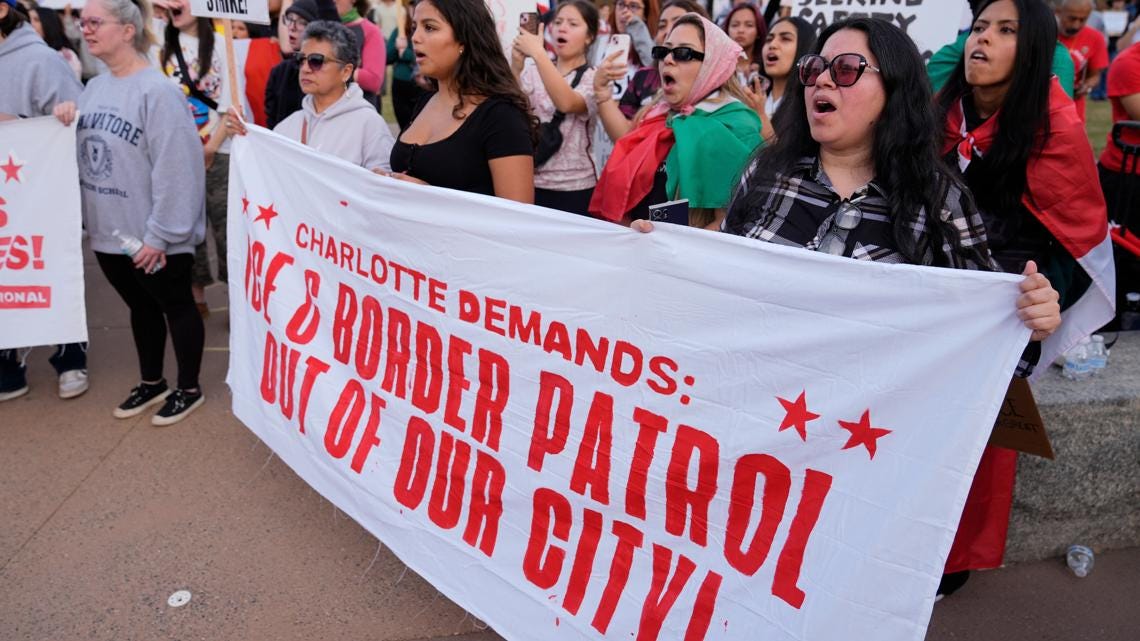Charlotte Set a New Standard for Resisting ICE
If they thought Charlotte would break, they miscalculated. Inside: the proof, the tactics, and the shareable content to spread what really happened.
The Digital Drumbeat by DemCast is fueled by defiance and determination. Subscribe—free or paid—and stand with the writers, organizers, and dreamers keeping democracy alive.
In this issue:
Find inspiration in how Charlotte outsmarted a militarized deportation surge, 170 miles from any border.
Share the videos and stories that captured neighbors standing between their community and federal agents.
Access practical tools, rights guides, and the Community Defense Resource Hub to help you organize where you live.
A City Nowhere Near the Border Still Got Targeted
Charlotte sits 170 miles from the nearest coastline, far outside the interior enforcement zone described in federal guidance and long questioned in constitutional analysis. It does not fall inside the zone CBP keeps stretching across the country.
None of that stopped masked agents who swept into the city under an operation previewed in internal reporting. Attempts to frame the raid as routine collapsed immediately. This was political theater.
Charlotte refused to play along.
Two Hundred Agents, Zero Intimidation
More than 250 agents surged into Charlotte on November 15, arresting over 130 people in two days and smashing the windows of U.S. citizens asserting their rights. Some outlets tried to soften the sweep in early accounts, but no spin matched what residents saw.
That night, more than 300 people packed a church for community defense training run by Siembra NC. Monday nights usually belong to rest. Charlotte used theirs to prepare. As Jacob Soboroff reported live, the turnout stunned even seasoned faith leaders.
Training Became Real-Time Resistance
Residents moved from learning to action within hours. They formed safety patrols, stood outside businesses, and placed themselves between agents and neighbors. One attendee said the community presence forced agents to abandon an attempted detention in a grocery store lot.
Students made the next move. Hundreds walked out of Olympic High, East Mecklenburg, and other schools. Wearing black and carrying signs, they showed a moral clarity many adults avoid. When injustice becomes law, resistance becomes duty.
Businesses followed. A bakery that had stayed open nearly thirty years closed to protect its workers. People mattered more than profit.
The Streets Belong to the People
Protesters filled the streets outside shops, parks, and the DHS office. Students, clergy, and neighbors stood united. Community reporting captured Charlotte’s message: you will not intimidate us.
Nothing about the raid aligned with actual enforcement. The “100-mile rule,” critiqued in legal analysis, already strains constitutional limits. Charlotte sits seventy miles outside even that boundary.
They picked the wrong city.
Charlotte Became the New Blueprint
Rachel Maddow underscored why Charlotte matters nationally. Cities like Los Angeles and Chicago tested community defense. Charlotte expanded it.
Siembra NC had built the infrastructure long before the raid. Their rapid-response networks, safety-patrol guides, and rights-education materials sit openly in their public organizing hub.
Charlotte exposed the authoritarian playbook: rely on shock and hope communities freeze. Charlotte did the opposite.
Authoritarians Expect Silence. Charlotte Gave Them a Choir.
Agents can hide behind masks and unmarked vehicles, but they cannot break a community that shows up.
When neighbors intervene, when students walk out, and when businesses protect workers, intimidation cracks.
Charlotte lit the path.
Now every community decides whether it stays quiet or rises.
And Charlotte proved one truth: when people choose each other over fear, authoritarianism doesn’t stand a chance.
These videos speak louder than any press release. Share them.
The kids are alright!
Charlotte Turns Out!
If Charlotte can stand up, so can every community.
Start with the tools that help communities prepare:
• Know your rights inside interior enforcement zones
• Explore practical organizing tools and safety trainings
• Understand the legal landscape CBP relies on




This issue brought tears to my eyes and made me proud of my country again. Thank you, Charlotte. Way to go!
If they thought the cities in the South would let them terrorize our neighbors, they thought very wrong. Side note - I think the technicality with being in Charlotte is that Charlotte has an international airport. Those function as borders too so the 100 mile radius would apply to most of the USA, actually.